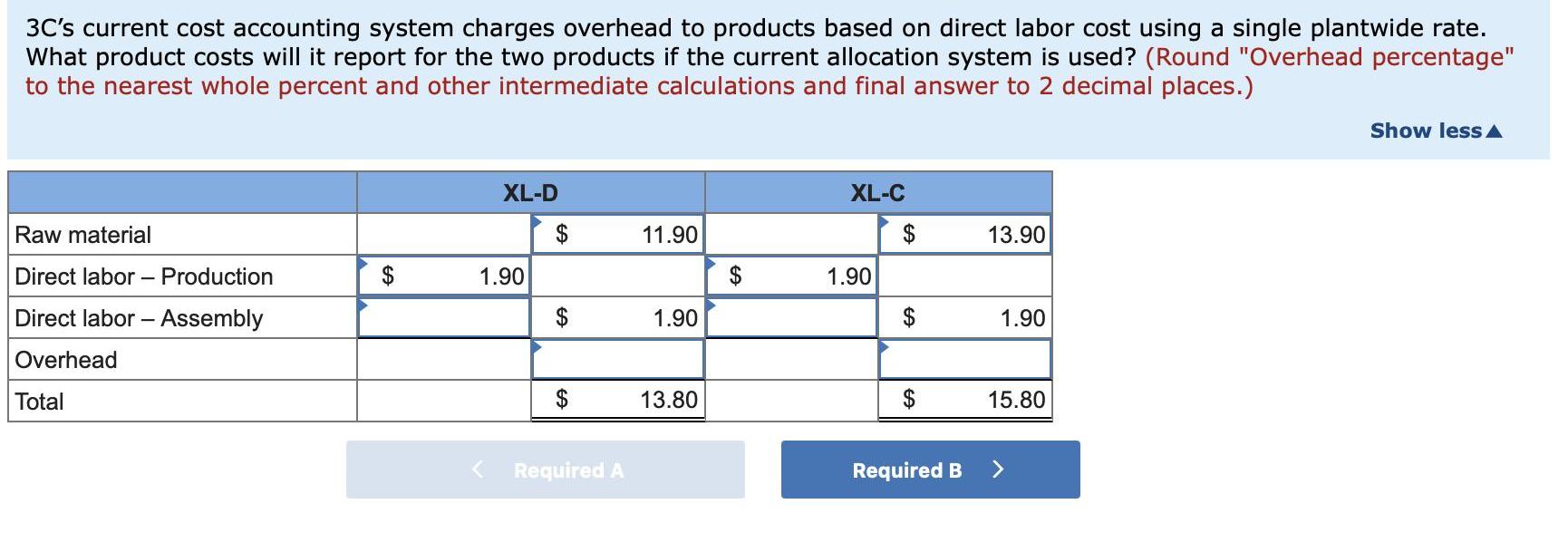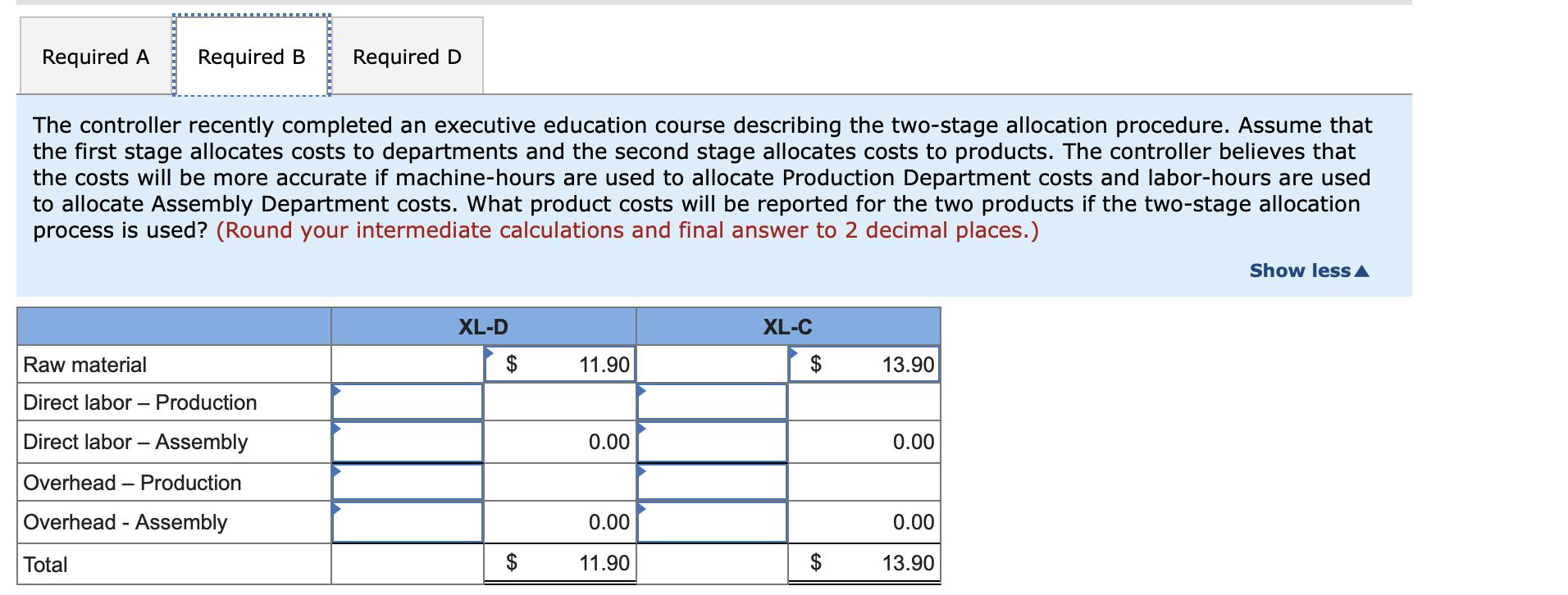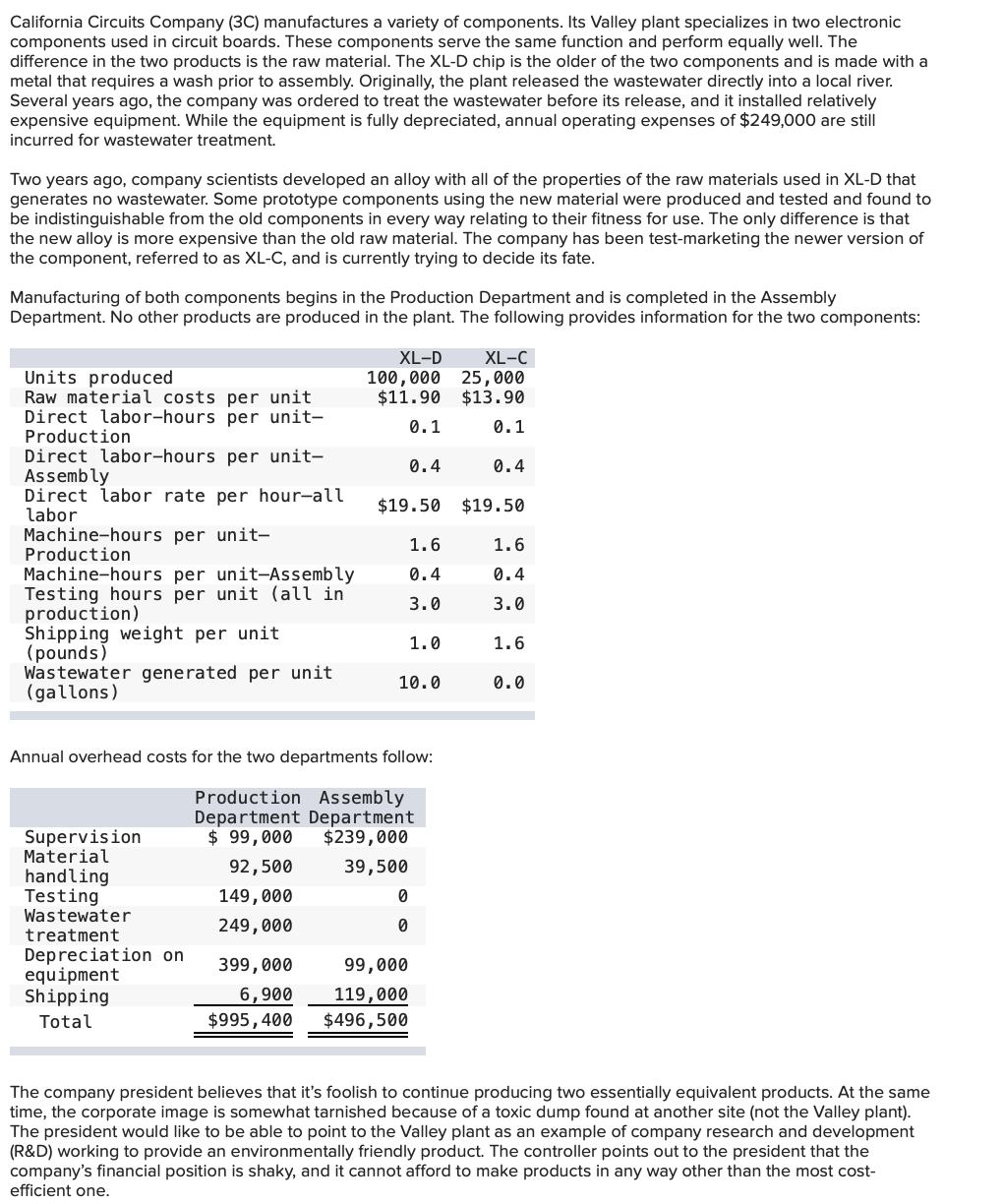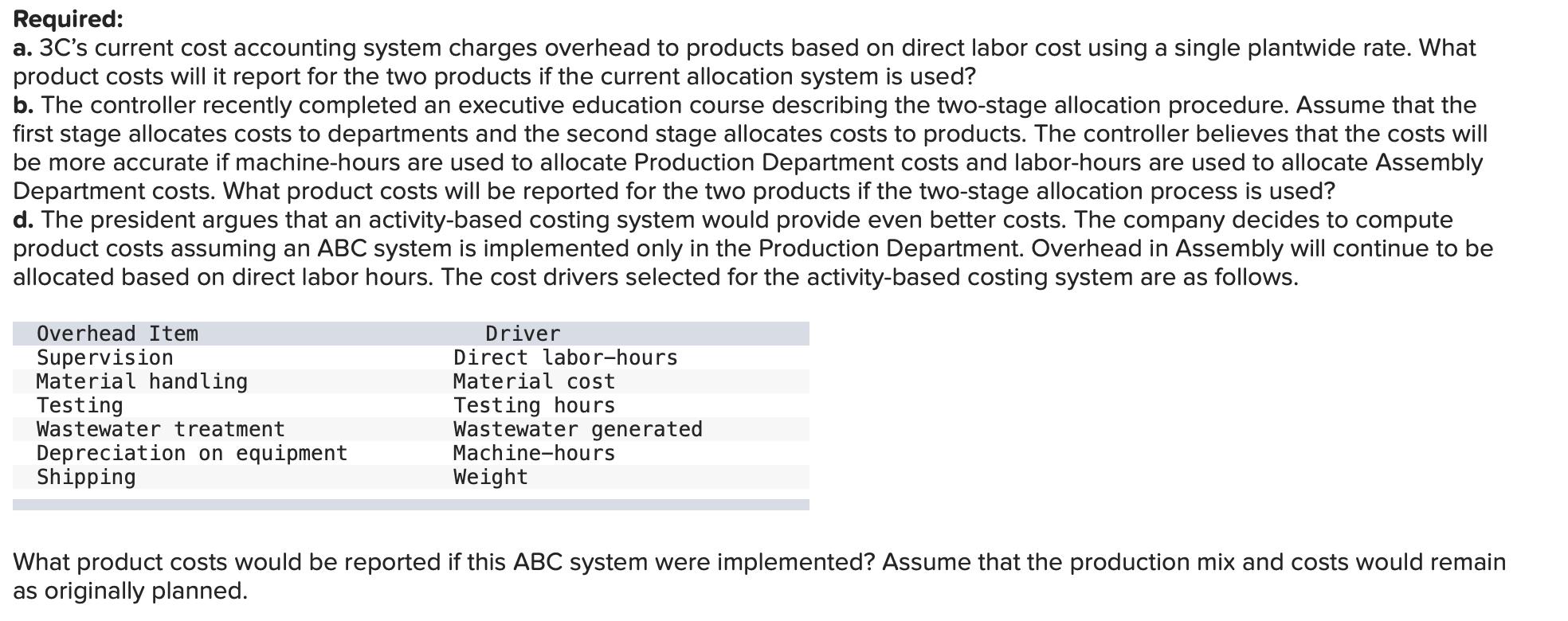Answered step by step
Verified Expert Solution
Question
1 Approved Answer
3C's current cost accounting system charges overhead to products based on direct labor cost using a single plantwide rate. What product costs will it





3C's current cost accounting system charges overhead to products based on direct labor cost using a single plantwide rate. What product costs will it report for the two products if the current allocation system is used? (Round "Overhead percentage" to the nearest whole percent and other intermediate calculations and final answer to 2 decimal places.) Show less XL-D XL-C Raw material $ 11.90 $ 13.90 Direct labor-Production $ 1.90 $ 1.90 Direct labor-Assembly $ 1.90 $ 1.90 Overhead Total $ 13.80 $ 15.80 Required A Required B > Required A Required B Required D The controller recently completed an executive education course describing the two-stage allocation procedure. Assume that the first stage allocates costs to departments and the second stage allocates costs to products. The controller believes that the costs will be more accurate if machine-hours are used to allocate Production Department costs and labor-hours are used to allocate Assembly Department costs. What product costs will be reported for the two products if the two-stage allocation process is used? (Round your intermediate calculations and final answer to 2 decimal places.) Raw material XL-D $ XL-C 11.90 $ 13.90 Direct labor - Production Direct labor-Assembly 0.00 0.00 Overhead - Production Overhead - Assembly 0.00 0.00 Total $ 11.90 $ 13.90 Show less Required A Required B Required D What product costs would be reported if this ABC system were implemented? Assume that the production mix and costs would remain as originally planned. (Round your intermediate calculations and final answer to 2 decimal places.) Raw material Direct labor - Production Direct labor-Assembly Overhead - Production Supervision Material handling Testing Waste treatment Depreciation Shipping Total production overhead Overhead - Assembly Total XL-D $ 11.90 0.00 0.00 XL-C $ 13.91 0.00 0.00 11.90 $ 13.91 California Circuits Company (3C) manufactures a variety of components. Its Valley plant specializes in two electronic components used in circuit boards. These components serve the same function and perform equally well. The difference in the two products is the raw material. The XL-D chip is the older of the two components and is made with a metal that requires a wash prior to assembly. Originally, the plant released the wastewater directly into a local river. Several years ago, the company was ordered to treat the wastewater before its release, and it installed relatively expensive equipment. While the equipment is fully depreciated, annual operating expenses of $249,000 are still incurred for wastewater treatment. Two years ago, company scientists developed an alloy with all of the properties of the raw materials used in XL-D that generates no wastewater. Some prototype components using the new material were produced and tested and found to be indistinguishable from the old components in every way relating to their fitness for use. The only difference is that the new alloy is more expensive than the old raw material. The company has been test-marketing the newer version of the component, referred to as XL-C, and is currently trying to decide its fate. Manufacturing of both components begins in the Production Department and is completed in the Assembly Department. No other products are produced in the plant. The following provides information for the two components: XL-D Units produced 100,000 XL-C 25,000 Raw material costs per unit Direct labor-hours per unit- Production $11.90 $13.90 0.1 0.1 Direct labor-hours per unit- Assembly 0.4 0.4 Direct labor rate per hour-all labor $19.50 $19.50 Machine-hours per unit- 1.6 1.6 Production Machine-hours per unit-Assembly 0.4 0.4 Testing hours per unit (all in 3.0 3.0 production) Shipping weight per unit 1.0 1.6 (pounds) Wastewater generated per unit (gallons) 10.0 0.0 Annual overhead costs for the two departments follow: Production Assembly Department Department Supervision $ 99,000 $239,000 Material 92,500 39,500 handling. Testing 149,000 0 Wastewater 249,000 0 treatment Depreciation on 399,000 99,000 equipment Shipping Total 6,900 $995,400 119,000 $496,500 The company president believes that it's foolish to continue producing two essentially equivalent products. At the same time, the corporate image is somewhat tarnished because of a toxic dump found at another site (not the Valley plant). The president would like to be able to point to the Valley plant as an example of company research and development (R&D) working to provide an environmentally friendly product. The controller points out to the president that the company's financial position is shaky, and it cannot afford to make products in any way other than the most cost- efficient one. Required: a. 3C's current cost accounting system charges overhead to products based on direct labor cost using a single plantwide rate. What product costs will it report for the two products if the current allocation system is used? b. The controller recently completed an executive education course describing the two-stage allocation procedure. Assume that the first stage allocates costs to departments and the second stage allocates costs to products. The controller believes that the costs will be more accurate if machine-hours are used to allocate Production Department costs and labor-hours are used to allocate Assembly Department costs. What product costs will be reported for the two products if the two-stage allocation process is used? d. The president argues that an activity-based costing system would provide even better costs. The company decides to compute product costs assuming an ABC system is implemented only in the Production Department. Overhead in Assembly will continue to be allocated based on direct labor hours. The cost drivers selected for the activity-based costing system are as follows. Overhead Item Supervision Material handling Testing Wastewater treatment Depreciation on equipment Shipping Driver Direct labor-hours Material cost Testing hours Wastewater generated Machine-hours Weight What product costs would be reported if this ABC system were implemented? Assume that the production mix and costs would remain as originally planned.
Step by Step Solution
There are 3 Steps involved in it
Step: 1
a Product Costs using Current Cost Accounting System To determine the product costs using the current cost accounting system we allocate overhead costs based on direct labor cost using a single plantw...
Get Instant Access to Expert-Tailored Solutions
See step-by-step solutions with expert insights and AI powered tools for academic success
Step: 2

Step: 3

Ace Your Homework with AI
Get the answers you need in no time with our AI-driven, step-by-step assistance
Get Started


